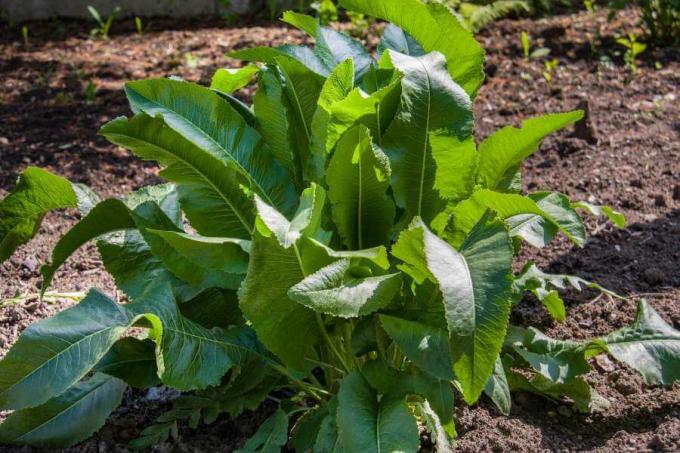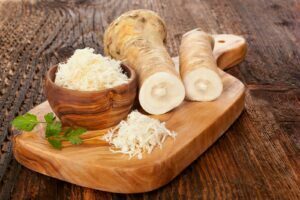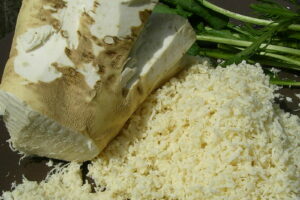Horseradish is hardy and easy to grow in your own garden. Nevertheless, the sharp root plant has some special features in cultivation.

horseradish (Armoracia rusticana) is one of the cruciferous plants (Brassicaceae). The thick taproot brings the characteristic spiciness to the kitchen. However, if the horseradish root is fried or boiled, it loses its taste and smell. Horseradish probably originated in southern and eastern Europe. But the sharp root has also been cultivated in this country since the Middle Ages. Winter temperatures cannot harm the horseradish - the cruciferous plant can withstand temperatures down to -50 °C. A bigger problem, however, is the Propagation of horseradish because not many seeds are formed. We will show you how you can still successfully grow the root crop in your garden.
Growing horseradish - step by step
- Location: Where the horseradish is grown, it should be as light as possible. The cruciferous plant tolerates a sunny location without any problems. In order for the taproot to develop optimally in terms of both diameter and length, cultivation on loose, well-drained soil is ideal. Loamy sandy soils or loess soils are ideal. On the other hand, soil that is too salty is not suitable for growing horseradish, as it is very sensitive to high salt levels. Unfortunately, due to the size that horseradish roots reach, the plant is not suitable for growing in pots.
- propagation: Horseradish forms little or no seeds. Sowing is at propagation of horseradish thus ruled out. Alternatively, the sharp root is propagated via side roots, so-called foxes. The side shoots of the taproot are separated and stored in autumn. From the end of March, the foxes can then be planted in the ground. Alternatively, the root side shoots can also be driven out in the warm to have a head start on growth. When planting out in the bed, make sure that the roots are placed in the soil at an angle and in the direction of growth. If the foxes lie too horizontally, no growth can be achieved; if they stand too vertically in the ground, the above-ground parts of the plant grow almost exclusively. The top 3 cm of the fencing should not be covered with soil. Since horseradish can spread quickly and new plants can grow from even the smallest root parts, you should think carefully about where the horseradish will find its place in the garden. If necessary, it can also make sense to specifically limit its growth with a rhizome barrier.
- Watering and fertilizing: Horseradish should be watered regularly, especially during the main growing season. Despite being grown in beds, watering several times a week may then be necessary. However, even and constant moisture is necessary for the formation and growth of the taproot. If some manure or compost is worked into the plant bed in autumn, this is sufficient for the horseradish to be supplied with sufficient nutrients. Alternatively, you can also use a primarily organic long-term fertilizer like ours when planting Plantura organic tomato fertilizer placed in the planting hole.
- Care for: The formation of the lateral roots cost the horseradish plant strength. To put all the energy into growing the thickened taproot, you can lift the plant up a bit with a digging fork in June and remove the unwanted lateral roots. However, this also creates possible entry points for unwanted diseases.
- To harvest: In addition to the coveted taproot of the horseradish, the young, fresh sprouts can also be tasty. These are simply partially cut off in the spring and are briefly fried - a small vegetable delicacy. The sharp roots are not harvested until autumn. As soon as the leaves begin to wither and dry up, the taproot will stop growing and harvesting can begin. This is usually the case from the end of October. Thanks to its pronounced winter hardiness, horseradish can also be pulled out of the ground later in the winter for freshly harvested use. If the root is not the right size, you can leave the plant for a second year and only harvest it next autumn, but then with a larger taproot.

- To store: A clear advantage of horseradish is of course that not everything has to be harvested at once. Freshly harvested horseradish can be brought into the kitchen again and again until it buds next spring. After that, you can extend the usability by storing it in a cool place. At optimal temperatures between -5 and -2 °C, the horseradish taproot can be preserved for several months. With increasing storage time, however, more and more of the characteristic sharpness is lost and the root loses its firm consistency. Unfortunately, the horseradish root is not suitable for drying - after that the sharpness is almost completely lost.
I have a master's degree in horticulture and I am also a qualified ornamental gardener. Ever since I was a child, I've been hooked on the subject of cultivation: Whether it's on the small city window sill or in the spacious garden - I have to garden anytime, anywhere, even in my free time.
Favorite fruit: raspberries
Favorite Vegetable: Broccoli
previous posts

Horseradish is known for its spicy root. But how is this harvested from the ground?

Horseradish cannot be propagated from seeds. However, the side roots can be planted to create a..

In different variations, horseradish spices up the kitchen. However, the cultivation of this plant falls..



